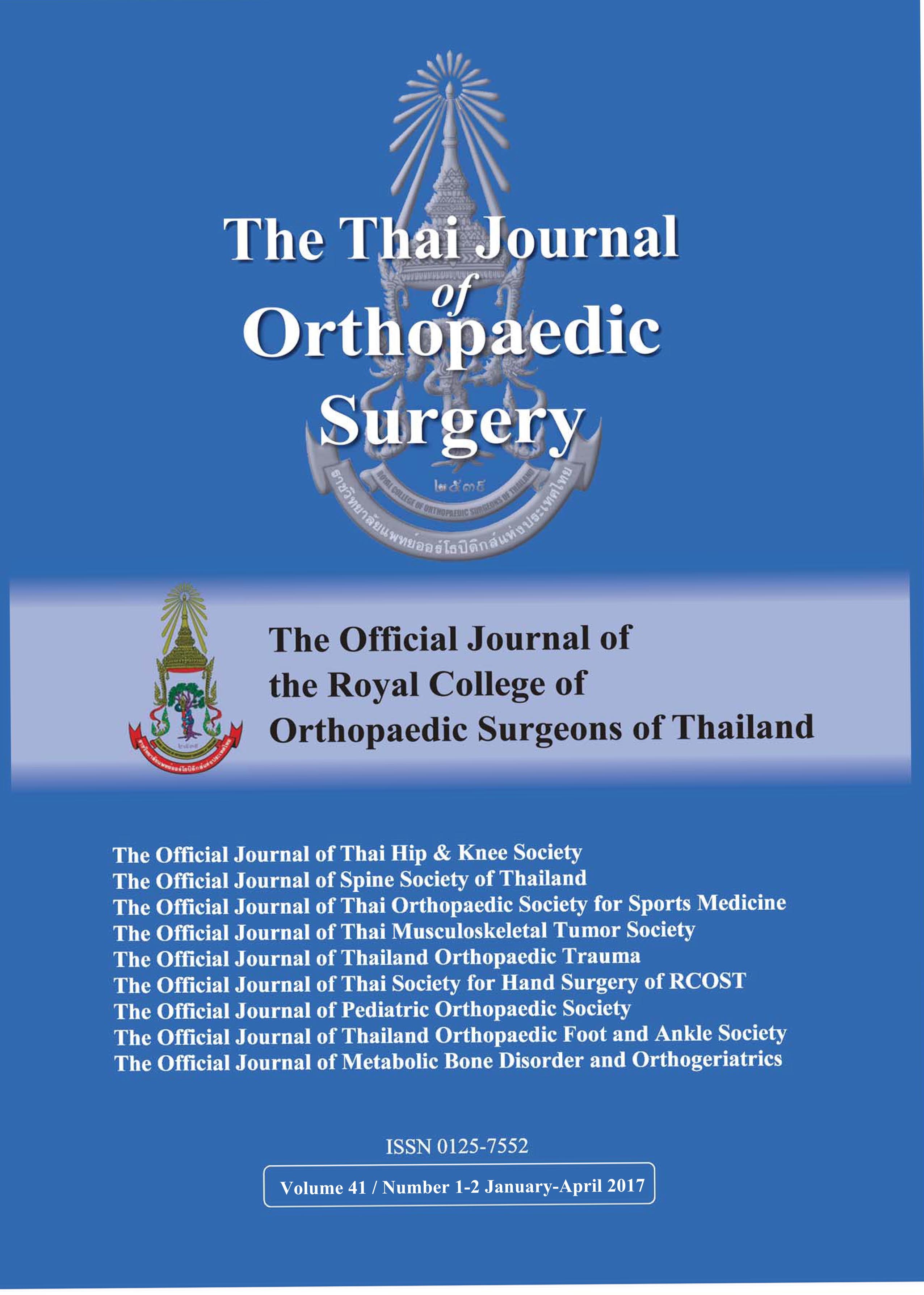Outcomes Following Reduction of Sanders Type III/IV Calcaneal Fracture Using Impaction Technique and Ligamentous Sparing
Main Article Content
Abstract
Purpose: To demonstrate the outcomes of the impacted reduction technique with plating fixation for Sanders type III-IV calcaneal fractures, without detaching the calcaneofibular and talocalcaneal ligaments.
Methods: Retrospective analysis of the calcaneal fractures Sanders type III-IV, which were treated with impacted reduction technique and plate fixation during January 2012 to December 2016 was conducted. Medical records and radiographies were reviewed for collecting demographic data and radiographic parameters. Pre-operative and post-operative radiographic parameters were compared.
Results: Twenty-seven consecutive calcaneal fractures were evaluated, in which 22 fractures (81.5%) were classified as Sanders type III, underwent the operative treatments at 14.8 days (range, 10-18 days). The impacted reduction technique was able to post-operatively restore the Bohler, Gissane, and varus angles, and the articular stepping from 8.2 (±17.3) to 27.2 (±4.8) degrees, with a mean difference of 19.0 (±17.2) degrees; 99.2 (±14.4) to 126.7 (±7.1) degrees, with a mean difference of 27.6 (±14.1) degrees; 7.3 (±3.6) to 4.4 (±1.1) degrees, with a mean difference of -3.0 (±3.2) degrees; and 4.3 (±0.9) to 0.7 (±0.7) millimeters, with a mean difference of -3.5 (±1.1) millimeters, respectively; with a statistically significant difference (P<0.001). Mean of the estimated blood loss, operative times, and union times were 78.7 milliliters, 99.2 minutes, and 3.5 months, respectively.
Conclusion: The impacted reduction technique for Sanders type III-IV calcaneal fractures improved the restoration of the post-operative Bohler angle, Gissane angle, varus malalignment, and articular stepping radiographic parameters.
Level of study: Level IV case series.
Article Details
References
2. Sharr PJ, Mangupli MM, Winson IG, Buckley RE. Current management options for displaced intra-articular calcaneal fractures: Non-operative, ORIF, minimally invasive reduction and fixation or primary ORIF and subtalar arthrodesis. A contemporary review. Foot Ankle Surg 2016; 22: 1-8.
3. Gusic N, Fedel I, Darabos N, Lovric Z, Bukvic N, Bakota B, et al. Operative treatment of intraarticular calcaneal fractures: Anatomical and functional outcome of three different operative techniques. Injury 2015; 46 Suppl 6: S130-3.
4. Persson J, Peters S, Haddadin S, O’Loughlin PF, Krettek C, Gaulke R. The prognostic value of radiologic parameters for long-term outcome assessment after an isolated unilateral calcaneus fracture. Technol Health Care 2015; 23: 285-98.
5. Su Y, Chen W, Zhang T, Wu X, Wu Z, Zhang Y. Bohler’s angle’s role in assessing the injury severity and functional outcome of internal fixation for displaced intra-articular calcaneal fractures: a retrospective study. BMC Surg 2013; 13: 40.
6. Barrick B, Joyce DA, Werner FW, Iannolo M. Effect of calcaneus fracture gap without step-off on stress distribution across the subtalar joint. Foot Ankle Int 2017; 38: 298-303.
7. Huang PJ, Huang HT, Chen TB, Chen JC, Lin YK, Cheng YM, et al. Open reduction and internal fixation of displaced intra-articular fractures of the calcaneus. J Trauma 2002; 52: 946-50.
8. Makki D, Alnajjar HM, Walkay S, Ramkumar U, Watson AJ, Allen PW. Osteosynthesis of displaced intra-articular fractures of the calcaneum: a long-term review of 47 cases. J Bone Joint Surg Br 2010; 92: 693-700.
9. Sanders R. Current concepts review: Displaced intra-articular fractures of the calcaneus. J Bone Jt Surg Am Vol Boston 2000; 82: 225-50.
10. Kobayashi T, Yamakawa S, Watanabe K, Kimura K, Suzuki D, Otsubo H, et al. The in situ force in the calcaneofibular ligament and the contribution of this ligament to ankle joint stability. Clin Biomech (Bristol, Avon) 2016; 40: 8-13.
11. Ringleb SI, Dhakal A, Anderson CD, Bawab S, Paranjape R. Effects of lateral ligament sectioning on the stability of the ankle and subtalar joint. J Orthop Res 2011; 29: 1459-64.
12. Tochigi Y, Takahashi K, Yamagata M, Tamaki T. Influence of the interosseous talocalcaneal ligament injury on stability of the ankle-subtalar joint complex--a cadaveric experimental study. Foot Ankle Int 2000; 21: 486-91.
13. Tochigi Y, Amendola A, Rudert MJ, Baer TE, Brown TD, Hillis SL, et al. The role of the interosseous talocalcaneal ligament in subtalar joint stability. Foot Ankle Int 2004; 25: 588-96.
14. Sanders R. Intra-articular fractures of the calcaneus: present state of the art. J Orthop Trauma 1992; 6: 252-65.
15. Wang CS, Tzeng YH, Lin CC, Huang CK, Chang MC, Chiang CC. Radiographic evaluation of ankle joint stability after calcaneofibular ligament elevation during open reduction and internal fixation of calcaneus fracture. Foot Ankle Int 2016; 37: 944-9.
16. Vittore D, Vicenti G, Caizzi G, Abate A, Moretti B. Balloon-assisted reduction, pin fixation and tricalcium phosphate augmentation for calcanear fracture. Injury 2014; 45 Suppl 6: S72-9.
17. Cottom JM, Baker JS. Restoring the anatomy of calcaneal fractures: A simple technique with radiographic review. Foot Ankle Spec 2016.
18. Cao L, Weng W, Song S, Mao N, Li H, Cai Y, et al. Surgical treatment of calcaneal fractures of Sanders type II and III by a minimally invasive technique using a locking plate. J Foot Ankle Surg 2015; 54: 76-81.
19. Sivakumar BS, Wong P, Dick CG, Steer RA, Tetsworth K. Arthroscopic reduction and percutaneous fixation of selected calcaneus fractures: surgical technique and early results. J Foot Ankle Surg 2015; 54: 76-81.
20. Dayton P, Feilmeier M, Hensley NL. Technique for minimally invasive reduction of calcaneal fractures using small bilateral external fixation. J Foot Ankle Surg 2014; 53: 376-82.
21. Jacquot F, Letellier T, Atchabahian A, Doursounian L, Feron JM. Balloon reduction and cement fixation in calcaneal articular fractures: a five-year experience. Int Orthop 2013; 37: 905-10.


